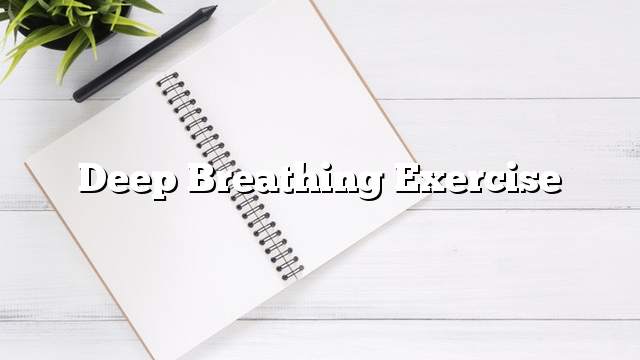Deep breathing exercise
Deep breathing exercise means entering the air into the abdomen and taking it out slowly. This exercise helps to relieve [breathing], and to do the following:
- Lying on the back.
- Place the hand above the abdomen.
- Take a deep breath from the nose, allowing the abdomen to expand by filling the lungs with air.
- Hold the air for a few seconds.
- Slowly remove the air through the mouth (exhale), and discharge the lungs from the air.
- Repeat this exercise for 5-10 minutes and can exercise several times a day.
Fumigation
Steam inhalation helps to get rid of airway obstruction in the nose, that is, it helps breathe more easily. The heat and humidity from the steam can interfere with the mucus in the lungs, thus eliminating the shortness of breath.
- Fill the pot with hot water.
- Add a few drops of mint oil or Kenyan oil.
- Place the face over the container, covering his head with a towel.
- Take the same deep and inhaled steam.
Note: Caution should be taken if the water is heavily damaged, as steam can cause burns to the face.
Lip clenching during breathing
Lip clenching during breathing is a simple way to control shortness of breath, it helps to control the fast-paced breathing, making the breathing process deeper, and is following the following steps:
- Relaxing neck and shoulder muscles.
- Breathe slowly through the nose with count to 2.
- Lip Balm (F shape).
- Breathe slowly and gently through the mouth with count to 4.
Breathing of the diaphragm muscle
Breathing can be done through the diaphragm muscle by:
- Sit on a chair with your knees bent and relax your shoulders, head, and neck muscles.
- Place the hand on the abdomen.
- Breathing slowly through the nose (inhalation), meanwhile you should feel that the abdomen is moving (expands) under the hand.
- Breathe slowly through the mouth (exhale), and during exhalation you must feel that the abdomen is moving inside.
- Repeat this process for approximately five minutes.
Conditions to get rid of breathlessness
There are different situations that can be done by any person suffering from shortness of breath:
- Situations:
- The first sitting position: resting the feet on the ground and tilting the chest forward, resting the elbows on the knees, or placing the chin on the hands, and then relax the muscles of the neck and shoulder.
- Second sitting position: resting the feet on the ground and tilting the chest forward, resting the arms on the table, then placing the head on the forearms, or on some pillows.
- Stand positions:
- Position the first stand: stand with the distance between the feet are equal with the width of the shoulders, and then tilt the hip towards the wall with the hands on the thighs, and tilt the shoulders a little forward, and keep the arms hanging forward.
- Second position: Rest the elbows or hands on a piece of furniture, but the height should not exceed the height of the shoulder, and then relax the muscles of the neck and shoulders with the rest of the head on the forearms.
- Lying positions:
- First lying position: Lie on the right or left side with a pad between the legs, then lift the head slightly on the pillow, and keep the back straight.
- Second lying position: lie on the back and lift the head on the pillow, then put the pillow under the knees, keep the back straight.
Other tips
Use a small fan
Many studies have shown that using a small hand fan and directing it to the face of a person with shortness of breath increases the amount of air flowing through the nose or mouth, thus reducing the sense of shortness of breath.
Drinking coffee
Studies suggest that drinking coffee improves lung function for up to four hours, because it contains caffeine that will relax the muscles in the airways of people with asthma.
